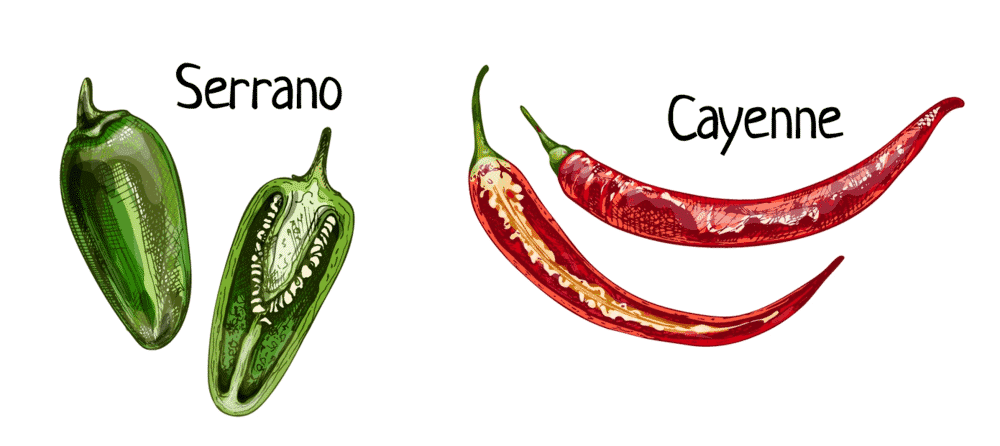
If you are reading this, it’s certain that you are familiar with spicy food, but many of us struggle to differentiate between different peppers. It might sound surprising, but different peppers have various spiciness levels.
For this reason, people are often confused about serrano vs. cayenne, so we are sharing the details about both these peppers with you!
Serrano Pepper vs Cayenne Pepper
Serrano Pepper
This is one type of chili pepper that has the origin in mountainous regions of Mexico, known as Hidalgo and Puebla. These peppers look a lot like jalapeno pepper in terms of color, but the size is smaller. To illustrate, serrano pepper has a 1.5-inches width with one-inches to four-inches length. In some cases, serrano pepper also grows longer.
These peppers are meatier, but they don’t have the best flavor when dried. The serrano pepper is available in yellow, orange, red, and/or brown colors. However, the majority of serrano pepper is available in green color (yes, just like jalapeno peppers). Serrano pepper is widely used in relishes, sauces, salsas, garnishes, and more. Also, it’s perfect for making hot sauce.
The serrano peppers have the best flavor when they are roasted. However, the peppers can be consumed in pan-cooked, roasted, and fresh forms. The fresh serrano peppers are suitable for garnishing if you want to add a spicy kick to food. For the most part, these peppers have a fresh flavor, and roasted ones are equally delicious.
Serrano peppers are perfect for making spicy meals since they add flavor and heat. The serrano peppers are extremely easy to grow, which makes them readily available in grocery stores. Generally, these peppers grow in warm temperatures but cannot be grown in chilly temperatures. For the most part, the serrano pepper plant is highly productive and can be grown in your garden as well.
The serrano peppers in unripe form have a green color and will grow up to 3-4-inches. These peppers can be eaten at any time once they start growing, but the flavor will be different for ripeness level. On the other hand, the serrano pepper will turn from green to red and then yellow or orange. We suggest that you pick the peppers when they are green to get the best flavor.
As far as the flavor is concerned, serrano pepper has a mildly sweet flavor, and colors will add appeal to the recipe. However, it also has an ample spicy and hot touch!
Cayenne Pepper
Cayenne pepper is one form of capsicum which is popular as the moderately-hot hot chili peppers that are used for flavorful dishes. Generally, these peppers are 10cm to 25cm in length but are extremely skinny. For the most part, cayenne pepper is available in red color and has a curved tip. The majority of cayenne peppers have rippled skin.
Cayenne peppers are dried and grounded to make the powdered (the powdered form is easier to use). However, some variants are available with a mixture of different peppers and won’t have the seeds. Due to its spiciness, it is used for making spicy recipes (it can be added in whole form as well as powdered form). In some cases, cayenne pepper is used as an herbal supplement.
When it comes down to egg dishes, such as omelets, deviled eggs, souffles, the dried cayenne pepper powder is used. In addition, the powdered form can be used in meats, casseroles, seafood, cheese recipes, curries, hot sauces, stews, and gravies. What we love most about this pepper powder is that it makes a perfect addition to pizzas.
As far as the spiciness is concerned, it has around 30,000 SHUs to 50,000 SHUs. These peppers are related to jalapenos as well as bell peppers (close cousin, maybe?). It is readily available in grocery stores since it’s easy to grow and ground. As for the origination, cayenne pepper originates from French Guiana. Also, we love how it can be added to shakers just like pepper and salt.
The cayenne pepper is widely used in Western recipes, and we have already mentioned the dishes. The powdered form is made by drying the fresh cayenne peppers and grinding them. Also, it’s essential to note down that it can be used in fresh form, but it’s hard to find. Lastly, it is easy to grow and produce in colder temperatures.